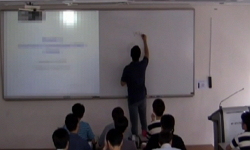최근 실리콘 반도체 기술의 발달로 시료에 ~수 nm까지 접근하여 그 특성을 파악하고 있다. 이는 파장보다 작은 지름의 aperture 제작하여 near-field의 빛으로 회질현상으로 인한 분해능의 한계를 ...
http://chineseinput.net/에서 pinyin(병음)방식으로 중국어를 변환할 수 있습니다.
변환된 중국어를 복사하여 사용하시면 됩니다.
- 中文 을 입력하시려면 zhongwen을 입력하시고 space를누르시면됩니다.
- 北京 을 입력하시려면 beijing을 입력하시고 space를 누르시면 됩니다.
Fabrication of Submicron size Aperture for Liquid Metal Ion Souce and Near Field Optical Sensor Application
한글로보기https://www.riss.kr/link?id=A75014808
-
저자
Lee, J.W. (###############################################################################################################################################################################################################################################################) ; Choi, S.S. ; Kim, J.W. ; Jung, M.Y. ; Kim, D.W.
- 발행기관
- 학술지명
- 권호사항
-
발행연도
2001
-
작성언어
Korean
- 주제어
-
KDC
560.000
-
자료형태
학술저널
-
수록면
44-48(5쪽)
- 제공처
-
0
상세조회 -
0
다운로드
부가정보
국문 초록 (Abstract)
최근 실리콘 반도체 기술의 발달로 시료에 ~수 nm까지 접근하여 그 특성을 파악하고 있다. 이는 파장보다 작은 지름의 aperture 제작하여 near-field의 빛으로 회질현상으로 인한 분해능의 한계를 극복할 수 있는 광학 현미경의 발달로 가능하다. 빛은 크게 far-field영역의 진행파와 near-field영역의 소민파로 나눌 수 있는데 기존의 일반적인 광학 현미경은 far-field optics로서 근본적으로 회설 현상으로 인한 분해능의 한계가 있다. 그러나 이러한 문제점은 현미경의 자동범위를 한 파장( λ。)보다 작은 영역으로 한정시킴으로써 해결할 수 있다. 시료에 약 수nm로 근접하여 한파장 보다 작은 aperture 사이로 빛을 통과시키는데 이러한 형태의 NSOM에서 가장 중요한 point는 tip 끝의 작은 aperture이다. aperture의 크기가 작아지면 작아질수록 분해능은 향상되고 near-field의 효율은 감소한다. 기존의 이러한 optical probe는 흔히 fiber나 micropipette등을 구부려서 얇은 금속을 코팅하여 사용하였으나 반도체 공정으로 만으로는 tip이나 aperture를 재생산하기 힘들다. 더욱이 fiber probe의 경우에는 반도체 일괄 공정한 문제점을 해결하고자 실리콘을 사용한 sub-micron size aperture에 대한 제안을 하였다. 비등방적인 KOH 용액으로 습식식각하여 드러나 실리콘 V-groove에 결장면에 따라 다르게 나타나는 건식산화를 하였다. 산화율이 상대적으로 빠른 (111) 면을 식각 마스크로 하고 (100) 면과 그 밑의 실리콘을 ICP(Inductively Coupled Plasma)를 이용한 RIE(Reactive Ion Etching)로 지름이 약 100nm의 aperture를 제작하고 계속해서 독립적인 산화벽 sensor로 만들고자 backs-side를 식각하여 최종적으로 submicron-size aperture를 제작하였다. 본 논문에서 제안된 이론은 반도체 일괄공정을 통해 재연이 가능하고 수율이 높으며 RE power와 식각 시간을 조정하여 다양한 크기의 submicron-size hole과 aperture의 제작이 가능한 장점이 있다. 본 구조물은 near field optical sensor 나 liquid metal ion source에 응용되어질 것이라 예상된다.
다국어 초록 (Multilingual Abstract)
There have been considerable interest and development in near field scanning optical microscope(NSOM) due to shortcomings of the conventional optical microscope, Abbe limit (λ/2), resolution limit from diffraction phenomena of light. 'I'he resolution...
There have been considerable interest and development in near field scanning optical microscope(NSOM) due to shortcomings of the conventional optical microscope, Abbe limit (λ/2), resolution limit from diffraction phenomena of light. 'I'he resolution limit of the NSOM will be dependent upon two factors, i.e., the distance between the sample and the metal aperture of NSOM and the size of' the metal aperture for near field light source or sensor. The NSOM can he utilized as 'reading' technology for tera-size memory or a nanotechnology capable of examining the phenomena for the living cell. The several techniques has been suggested to fabricate the near field sensor including a SiN tip with a metal aperture for parallel SFM and NSOM application. There have been serious difficulties in fabricating a new field sensor on a cantilever array. In this work, we present a novel fabrication of a nanosensor - a submicron aperture for NSOM, and a possible liquid metal ion source. The fabrication of the submicron-size hole was microfabricated using conventional semiconductor process including photolithography, an anisotropic KOH etching, dry oxidation, reactive ion etching. The fabricated SiO₂aperture can be further-fabricated as NSOM sensor or liquid metal ion source with proper metal coating.
목차 (Table of Contents)
- 1. Introduction
- 2. Experimental Procedures and Discussion
- 3. Conclusion and Its Application
- 4. References
- 1. Introduction
- 2. Experimental Procedures and Discussion
- 3. Conclusion and Its Application
- 4. References
동일학술지(권/호) 다른 논문
-
Effect of Gas Exposures on Field Emission Properties of Carbon Nanotube Arrays
- 선문대학교 첨단과학기술연구소
- Lim, Seong-Chu
- 2001
-
Atomic-size Writing of SUN-MOON UNIVERSITY using 200 keV Electron Beam Lithography
- 선문대학교 첨단과학기술연구소
- Choi, Seong Soo
- 2001
-
Biosynthetic Studies on the a-Glucosidase Inhibitor Acarbose and Validamycin A
- 선문대학교 첨단과학기술연구소
- Sauerbrei, Bernd
- 2001
-
Gene Cloning and Analysis of Biosynthetic Gene of Spectinomycin
- 선문대학교 첨단과학기술연구소
- Sohng, Jae-Kyung
- 2001




 RISS
RISS






